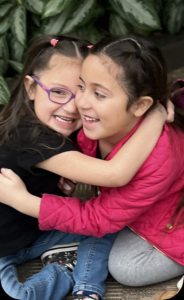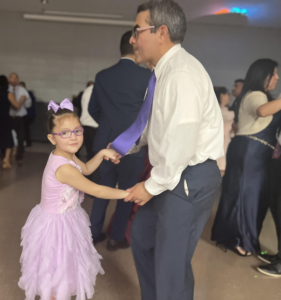The Child Neurology Foundation helps families throughout the course of their journey. Thanks to the generous support of the Harnett Family, the Child Neurology Foundation can provide one $1,000 grant to a family with a child with infantile spasms. The grant helps families cover their medical bills not covered by insurance. CNF talked with Lea Pasos, whose family received the 2022 Harnett Grant, to learn her story.
Tell us about your daughter, Mia.


Mia (left) began having Infantile Spasms when she was 2 months old.
Our family lives in Oklahoma, and my daughter Mia is 5 years old – she’s the youngest of my two daughters.
I had a healthy pregnancy, and for the most part, the delivery went fine except for her having a fractured collarbone when she was born. When she was 2 months old, we noticed her seizures – her eyes were dilating to one side, and she was shaking. Right away, we took her to the ER, and then she was transferred by helicopter to a children’s hospital, where they did a lot of tests to rule out different conditions before diagnosing her with epilepsy. They put her on her first epilepsy medication, and she stopped having seizures. It was a traumatic experience, but we were grateful to find a solution so quickly.
She seemed to do well for a couple of weeks, but then I started noticing a new movement. It was like she was puckering her lips, and her head would move to one side. We were waiting to get into the neurologist when that stopped, and then she started arching her back in clusters (I didn’t know they came in clusters at the time, but you learn so much over time).
What questions did you have at the time?
So many.
“What’s causing this? Will it keep happening? Are there support groups or resources?”
At the time, I wasn’t big into Googling stuff. I was trying to be a relaxed mom, but that all went down the drain. I wish I had known more, but when you are thrown into this without warning, there is just so much coming at you and so many unknowns.
What happened next?
Mia was admitted to the hospital for an EEG. The neurologist was working remotely because there was only a handful in our state, which was very difficult because different doctors there had to give us the news that she was having infantile spasms (IS).
To learn about causes, testing, treatment options, and more information about Infantile Spasms, visit our Disorder Directory.
It was such big news, and there was so much we didn’t know at the time. Even after having Mia undergo genetic testing, we still do not know the cause.
We started giving her steroid shots, and after two weeks, her seizures stopped. We were thankful, but it was still very scary that we didn’t know the underlying cause. By this time, she was also delayed in some developmental milestones, and we were worried about how much of what makes her ‘her’ we would lose. But thankfully, she started babbling again and began to progress in other ways as she came off the steroids.
A little while later, I noticed that she was experiencing head drops. I again rushed her to the ER in hopes that we might be able to get to the bottom of what was happening. They couldn’t see IS on the EEG at first and they tried medicine, but the head dropping continued to the point where she was hitting her head all the time, which was very scary to see.
Fortunately, a second EEG showed the IS happening. Our neurologist advised us that doing another round of steroids can be very hard on a baby’s body, so we looked into a ketogenic diet, but they told us this would be too hard for a baby. But the medications they offered us kept failing, and her IS kept happening. It was a very frustrating time.
What resources helped you?
Through the Epilepsy Foundation, I found another mom who had a similar experience. She asked if I had ever been to a Level 4 Epilepsy Center or seen an epileptologist. I didn’t even know that these were options, so once I learned about them, we drove our family of four from Oklahoma to a children’s hospital in California.
Mia’s seizures were still happening at this time, and her development was regressing. It felt like we were once again losing our little girl. We were so glad to hear that the children’s hospital was supportive of the ketogenic diet. So I found a nutritionist and a dietician and advocated to our neurologist back in Oklahoma that we could and would be doing this.
For more information on how a ketogenic diet can help with Infantile Spasms, visit our Epilepsy Education Hub.
How are things today?


Mia, now 5, has been seizure-free for over 4 years.
After a month after being on the ketogenic diet, her seizures stopped, and by the time she turned 1 year old, her EEG came back clean.
The diet wasn’t easy to follow and was an extreme change to our life initially, but it was worth it because it worked. Now she’s 5 years old, and she’s been seizure-free for four and a half years.
After a few years, we started to wean her off the diet slowly, and as of last September, she was completely off the diet and can now eat whatever she wants. It was scary to wean because the diet was her medication, and I had become so committed to following it, but it was time to adjust her off of it, and she’s been doing great!
Today, Mia gets speech and physical therapy. She’s outgoing and is going through a very independent stage right now. I have great hopes for her and her future.
How did the Child Neurology Foundation and Harnett Grant help?
It was very validating to receive the grant to support what our family has been going through. We still travel regularly to see our pediatric neurologist and therapist, and our insurance doesn’t cover the vitamins that Mia needed on the extreme ketogenic diet.
IS has impacted our whole family, so we are so grateful for the support. I would tell families to follow the Child Neurology Foundation because it will guide them with resources.
What other advice would you have for families?
Finding a pediatric neurologist specializing in epilepsy or seeing an epileptologist is my number one advice.
Be your child’s advocate – no one will fight for your child like you will. The doctors are great, but they have a lot of kids to treat, and you know your child best.
Some Facebook groups are helpful at times, and advocacy groups are also very helpful.
Don’t think you can’t do it! Take it a day at a time, and you will get through it.

